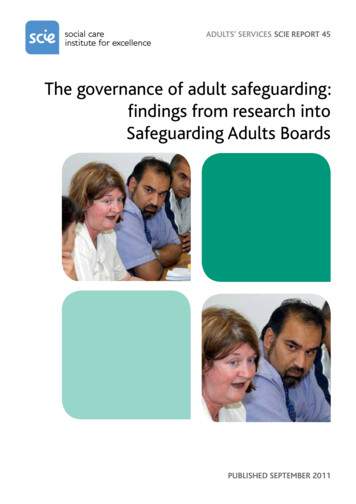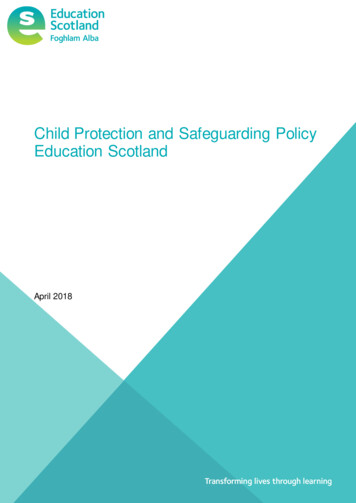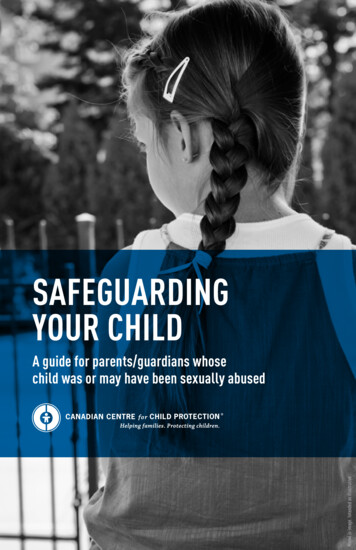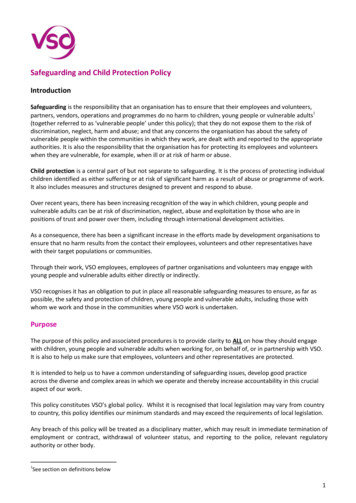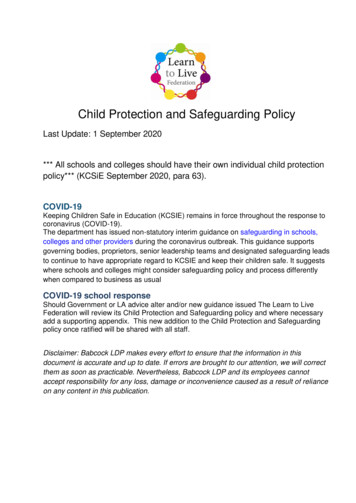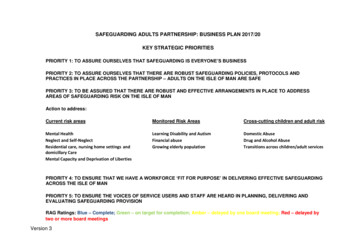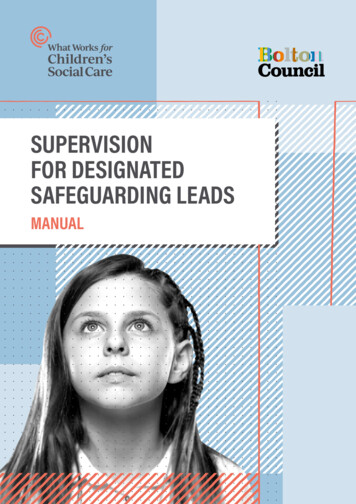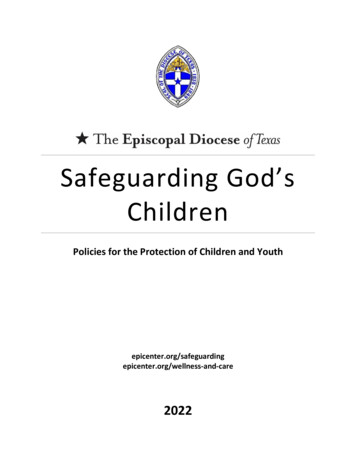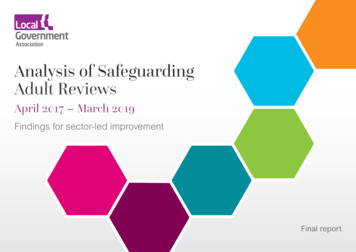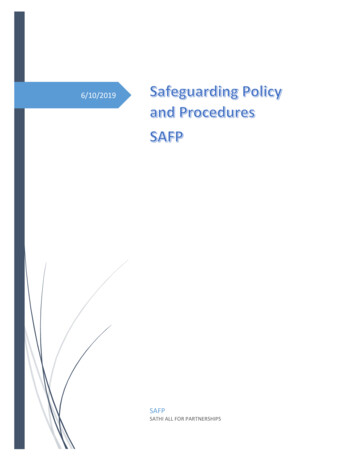
Transcription
6/10/2019SAFPSATHI ALL FOR PARTNERSHIPS
Table of ContentsPreface and acknowledgement . 5Safeguarding Policy and Procedures. 7Section I: What is safeguarding? . 71.1 Introduction . 7Safeguarding Role . 8 Awareness to build safeguarding capabilities: . 9 Learning to report abuse to evolve behaviors: . 9 Monitoring the compliance to revive commitment to safeguard . 9 Implications for the Partners . 91.2 Scope and limitation of this policy . 91.3 Policy authority and designate . 101.4 Safeguarding Policy Principles . 101.5 Legal backdrop. 111.6. Definitions. 11Section II: SAFP Safeguarding Policy . 151. Policy statements . 151.1 At the community level . 151.2 At the level of SAFP people . 152. Putting Policy into Practice . 162.1 Capacity for Safeguarding . 162.2 Demonstrate commitment and accountability. 172.3 Enable support through the governing process . 172.4Monitor, report, redress and record the healing / disciplining process . 17Section III. Safeguarding Procedures – Its practice in every day work. . 18A. Safeguarding SAFP assets and organization image . 18A. 1. Safeguarding safety and security . 18A.1.1 Security at work . 18PageA.2. Security of SAFP people . 201A.1.2 Aspects of building/workplace security . 19
A.3 Security Audit . 21A. 3 .1. Agree to the yearly safeguarding calendar . 21A. 3. 2 Monitor maintenance and capacity of assets and hardware as part of safeguarding . 21A. 4. Procedure for reporting a safeguarding concern. . 21A.4. 1 Understanding Concern and its context . 21A.4. 2. Working with partner organizations . 23A.4. 3. What will SAFP do to strengthen safeguard practice?. 24B.Safeguarding Human Resources . 24B. 1. Safe Recruitment . 24B. 2. Reference check before being designated as a SAFP people . 24B.3. Supervision practice induction to exit . 25B.4. Increasing awareness through a safeguarding calendar. 25B. 5. Safeguarding Children. 26B. 6. Safeguarding Vulnerable Adults . 27C. Safeguarding in SAFP programming . 30C.1. Safeguarding in over-all programming . 30C.2. Safeguarding in theme specific risk assessment, protection and mitigation . 31C. 3.Safeguarding in project management cycle . 32C.4. Safeguarding risk assessment approach of potential and current Partners . 32C.5. Implementation and Monitoring Safeguarding in Programmes . 33Section VI The Safeguarding Workplan. 34Annex 1 - SAFP Safeguarding the communication about children and vulnerable adults . 36Annex 2 - SAFP People Safeguarding Code of Conduct . 38Annex 3 - SAFP Policy on Whistle Blowing and the concern raising procedure . 41Complaint Handling Procedure . 45B.Partners Concern Reporting . 45C.Receiving a concern . 46D.Recording the concern . 46E.Processing the concern . 46F.Sensitive concerns . 47G.Investigation process . 47H.Communicating outcomes. 47PageA.2. 45
I.Appeals procedure . 48Annex 4 - Safeguarding Concern Report Form . 49Annex 5 - The safeguarding mechanism. 52Page3Annex 6 - Checklist format with an example of vendors checklist . 56
Complaint Handling M&ESCST (PA)RPWDSPPSAFPSOPCommunity Based OrganizationChild ProtectionDirector AdministrationDisaster Relief and RehabilitationDisabled Peoples OrganizationExecutive DirectorEmergency ReliefForest Right ActHuman ResourceNon-Government OrganizationPanchayat (Extension to Scheduled Areas) Act 1996Protection of Children from Sexual Offences Act 2012Prevention of Sexual Harassment Act 2013Persons with DisabilitiesMonitoring and EvaluationScheduled Castes and Scheduled Tribes (Prevention of Atrocities) Act 1989Rights of Persons with DisabilitiesSafeguarding Policy and PracticeSathi All For PartnershipsStandard operating ProceduresPageCHM4ACRONYMS
Preface and acknowledgementSafeguarding work in India has been done in bits and pieces by most organizations in India. This is so aslegal frameworks have evolved at different stages of jurisprudence development. The most recentlegislation has been prevention of sexual harassment at workplace. The protection of children from sexualoffenses was enacted just a year before. Due to this safeguarding is confused with protection from sexualoffenses. The reality is way beyond this understanding.Safeguarding in organizations: (i) the Global and Indian legal and cultural context has changed verydramatically in the last few years in the arena of Safeguarding, (ii) we have introduced the third pillar ofHealing and Closure in the Safeguarding system. Experience shows that the reporting, investigation anddecision announcement by the Management or the Disciplinary Committee involves substantial time,energy and emotions of not just the Committee members and persons involved, but also of other staff andthe organization as a whole. Most often it generates the development of a negative culture in theorganization full of grudges and speculations. Also leads to high attrition rate of both the offender and theabused. It also leaves many issues unresolved and finally (iii) in our research we have not seensafeguarding children and adults as part of the core social development programming. Child protectionprograming is a small mechanism in the overall safeguarding policy. SAFP therefore took the opportunityto present safeguarding in programming. The procedures for safeguarding in programming can be appliedto any theme by embedding it in the program cycle. Theme specific safeguarding framework should bedeveloped after conceptually understanding the difference between protection and safeguarding. Thistakes time which needs to be resourced and invested in HR and partnership development.This safeguarding policy with each partner is a co creation by understanding aspects of safeguarding thathelped SAFP to understand the needs for developing the policy and procedures as collated in thisdocument. Our team has researched a number of safeguarding policies and procedures developed in Indiaand outside. All visuals and diagrams have been taken from the internet except where acknowledged ascredited to SAFP. These visuals are used to facilitate understanding issues for conceptual clarity. Thedraft document was field tested to create the final document. We thank SAFP resource person Mr AmodKhanna for his input that this policy and the procedures, should remain fluid for the next three years. Thisis suggested as the process of owning the role of safeguarding is a very significant one to create a cultureof acceptance towards the role of safeguarding.With best wishesDr. Shivani Bhardwaj and Ms Deepika NairPage5Sathi All For Partnerships (SAFP)
6Page
Safeguarding Policy and ProceduresSection I: What is safeguarding?1.1 Introduction Safeguarding’ is an organizational and an individual responsibility. All Board members, staff,volunteers, SAFP representatives, visitors and vendors (both employed or otherwise and referredto collectively as ‘SAFP people’ in this policy) will be made familiar with the value and processof safeguarding children and vulnerable adults, beneficiaries and communities in operational areathat we come into contact with, in all that SAFP does . Safeguarding also extends to SAFPpeople with special reference to safeguarding themselves and their colleagues at workplaceincluding work in high risk areas and sensitive thematic concerns in different work contexts.SAFP serves the underprivileged sections of the society, hailing from socially excluded communities, theScheduled Caste and Scheduled Tribes, and religious minorities by exercising preferential actions for the mostmarginalized. She is committed to protect and promote the dignity of children and young people therefore ,SAFP takes their safeguarding very seriously. Even staff and volunteers may also go through challengingcircumstances exposing them to risks. envisages to have well established safeguarding systems, structures,and operational mechanisms are embedded into existing policies to ensure that SAFP does everything tosafeguard the children and adults she works with, and that she provides a safe and secure workingenvironment for everyone.What is Safeguarding?Safeguarding simply put is to protect adults and children to be safe from harm or damage or abusewith appropriate measure to mitigate risks in any given context.PageScope of safeguarding policy and target group differs from organization to organizationdepending on their mission, scale and diversity of operations. Accordingly, the presentation andformatting of focus and mitigation too is different. The concept of safeguarding is applicable toall businesses whether they are into people, habitat, ecology or working with other entities, i.e.the state, corporates, media, advertising and PR, academia, non-profit organizations etc.7Several factors have driven the increased attention paid to safeguarding. With increasingexposure to unsafe behavior and situations, and unpredictable natural hazards; children andadults are put to risks of being harmed and neglected. Additionally, increased reporting ofexploitation, abuse and accidents to workforce, collaborators, vendors and clients especially thelast user in all businesses; from the local to international; has forced all stakeholders to relookand reexamine internal and external related policies in their ecosystem. This is especially so ascountries have ratified International Conventions, treatise and legislations to be accountable tomitigate risks by people and institutions.
An over-arching safeguarding policy is required as aplethora of regulatory requirements, both within thecountry and abroad make organizations and their staffs,accountable where there is increased possibility thatcertain compliance requirements get missed. It also addsconsiderable cost to an organization’s compliance budgetand complexity to internal structures and informationneeds. Developing a strategy to lessen the restrainingeffects of compliance activities on the organization andits work is critical for its successful implementation.Safeguarding RoleThis safeguarding policy and procedures will coverentities, staff and other relevant people, vulnerable adults,children and reputation. These include:i.ii.iii.iv.v.Staff employed on full time or short positions,consultants on contracts and volunteers.Vendors, visitorsPartner organizationsCommunity especially children and vulnerableadults (in field area)Organisational image, use of assets and resultbased interventionsInternationalMost of the Aid agencies likePlan International and Savethe Children have scopedsafeguarding to sexual abuse,harassment and exploitationwith children and adults theycome in contact with. Otherslike World Bank, OXFAM andDFID include safeguardingsustainability, naturalresources, worker’s rights, andexclusion of geographies,marginalized people, abilities,sexual orientation and age.Civil society groups haveworked in different sectors todeal with discrimination inpolicies to make change at thelevel of procedure. Forexample, in Australia, theelderly can work till any age asthe country has recognizedage discrimination and workedon it actively.The organization then will build a culture of safeguardingfor prevention, identification, reporting and redressprocesses to keepchildren and vulnerable adults safe especially those at morerisk of harm. The organization is cognizant of specialcircumstances or contexts of work that can put children andadults at risk such as work in DRR and ER; anti-traffickingand work in conflict areas with different kinds of risks andmitigation needs.Diagram: Safeguarding cultureSafeguarding shapes the organization’s approach, practice and culture to ensuring a comprehensively safeenvironment for all people that the organization engages with.This policy is to guide SAFP people with a clear process to ensure:Page8Purpose of the Safeguarding policy
Awareness to build safeguarding capabilities: To live and work in a safe and protectchildren and vulnerable adults from all forms of harm, abuse, neglect and exploitationwhere possible, regardless of gender, age, ethnicity, disability, sexuality, sexual identityor beliefs.Learning to report abuse to evolve behaviors: Prevention, identification, reporting andredress processes for behavior change and/or disciplinary measure.Monitoring the compliance to revive commitment to safeguard: Ensuring that persondesignate for Safeguarding does safeguard SAFP r people including whistle blowers byoperating within a clear framework and defined procedures.The above requires safe recruitment and training to minimize the risk of abusers entering theorganization and mechanism to maintain safety and security. The monitoring and reportingprocess helps SAFP people to grow in their safeguarding role. Implications for the PartnersA policy on safeguarding is non-negotiable. Each partner will comply with this policy toeffectively implement the policy requirements in child protection, gender, inclusion, thematicconcerns and financial regulations. Therefore, partners must have their own Safeguarding Policythat provides the same or a higher level of protection than this policy, in full compliance withlocal law and best practice or abide by SAFP India’s Safeguarding Policy for the duration of thepartnership agreement/arrangement.1.2 Scope and limitation of this policyScopeSAFP India takes responsibility to a practice that protects her image, her staff, partners, childrenand vulnerable adults they come in contact with from any harm. This safeguarding policyprovides definitions and guidance on how to apply and implement this policy throughout theorganization with suggested procedures, in relation to SAFP, its partner organizations and in thecommunity in SAFP operational areas.Safeguarding and protection measures are also implemented through other SAFP in-housepolicies and procedures. These policies need to be read along with this safeguarding policy as anumbrella framework. Every policy when breached in the safe guarding context will need to berevised to include safeguarding elements. For example, the protection of the whistle-blower findsmention only in the SAFP human resource policy while it should be mentioned in all policies. Asan overarching safeguarding policy, this document will explain who the whistle blower is andwhat process they could follow. A separate whistle blower policy is drafted.Page9Limitation
This safeguarding policy limits itself to the communities SAFP and its partners work in. If anytransgression is observed or brought to the notice of SAFP outside their operational area, SAFPand its partners will report to appropriate authorities.1.3 Policy authority and designateCurrently, the policy authority is the SAFP management and the policy designate is the HumanResource Manager for the implementation of all in-house policies.It is suggested that an internal SafeguardingCommittee’ be constituted for a period of two years,while the policy authority and the policy designatecontinues its role. This safeguarding committee willbe responsible to revise all internal policies andguidelines for inclusion of appropriate safeguardingremit and procedures. This committee will also beresponsible for overseeing the process of embeddingsafeguarding policy practice and monitor the changein behavior and program approach. To this end,contract a Safeguarding Officer dedicated tocoordinate change in practice for a period of twoyears. S/He will report to the Steering committee.Following the successful embedding process, thesafeguarding remit will transfer on to the HumanResource Manager. A term of reference for theSafeguarding Committee is attached to this policy.PageThis safeguarding policy underpins the socialteachings of the Church and SAFP India’s visionand mission as mentioned in the strategic plan (2019to 2023). It focusses on the principle of Diakonia inall its strategic and operational considerations.Diakonia is the mission for establishing andsafeguarding justice and dignity, as the guiding force101.4 Safeguarding Policy Principles
of the Strategic Plan. Thus, safeguarding as a duty is sacred. It will follow the path of truth toprevent harm and when any incident occurs after corrective action there is to be healing of boththe victim and the perpetrator to reform and accept the repentance. Following are thesafeguarding policy principles:a.b.c.d.Underpins justice and dignity principlesAbides by the Values and Mission of SAFPIts compliance to the safeguarding policy is non-negotiableIs everyone’s responsibility.1.5 Legal backdropThis safeguarding policy will be implemented within the relevant Indian legal framework. Givenbelow is a list of relevant legislations for reference.a. National and global need; legislations and reporting; government safety standards;The Forest Rights Act, The SC/ST (Prevention of atrocities) Act 1989; (Panchayat)Extension to scheduled areas act 1996, POSCO Prevention of Sexual Harassment Act2013, Juvenile Justice and Care Act, Child Protection Act and the new amendment;Child Labor Prohibition Act 1986, Migrant Workmen (regulation of employment andconditions of service 1979), Rights of Persons with Disabilities Act; Mental Healthand Care Act, Anti-trafficking bill; Immoral Traffic (Prevention Act) 1956, ChildMarriage Act.b. Reference to the various judgements; the CSR discourse; Workmen compensationetc.c. The emerging relevant draft bills in the making are – Draft Personal Data Protectionbill 2018 of India; Compliance of the existing General Data Protection Regulation(GDPR) of the European Union; Trafficking of Persons bill 2018.1. 6. DefinitionsManagerManager refers to a Staff member who has responsibility for line managing or supervising the work ofStaff or Partners or Associates.StaffStaff refers to individuals who receive a regular salary for work in SAFP.VisitorIn line with the United Nations Convention on the Rights of the Child and for the purposes of this policy,is defined as any person – girl, boy, young woman, young man, and children of other gender identities under the age of 18 years (UNCRC Article 1)PageChild11Visitors refers to a range of persons who are visiting our offices or programmes, and may come intocontact with children and vulnerable adults through SAFP, including journalists, media, researchers,visiting sponsors and celebrities.
Vulnerable adultVulnerable adult for SAFP is a person aged 18 or over, in need of community care services byreason of mental or other disability, age or illness; and who is or may be unable to take care ofhim or herself, or unable to protect him or herself against significant harm or exploitation.’This policy applies to all children and vulnerable adults with whom SAFP has contact regardlessof gender, sexuality, religion or ethnicity. SAFP has in place other employment andorganizational policies that complement the Safeguarding Policy and help ensure the safety ofeveryone.SafeguardingSafeguarding is the proactive steps taken to prevent violence including, all forms of physical ormental violence, injury and abuse, neglect or negligent action. It is about taking responsibilitytowards, the preventive, responsive and referral measures undertaken for protection, ensuringthat no child or vulnerable adult is subject to any form of harm as a result of their associationwith SAFP This includes, ensuring that their contact with SAFP and those associated with SAFPand/or their participation in our activities, interventions and operations is safe and where thereare concerns over a child or vulnerable person’s welfare or where a child or a vulnerable personhas been subject to violence, appropriate and timely actions are taken to address this andincidents are analyzed so as to ensure continued learning and system strengthening for SAFP.Gender Responsive Safeguarding 1This is a safeguarding approach that takes full account of gender in considering the specificsafeguarding needs of girls, boys and other gender identities. This approach integratessafeguarding measures that address protection risks that stem from issues relating to gender biasand discrimination; and supports the empowerment and fosters the inclusion of girls, particularlyin the safeguarding process, in a manner that promotes equality, equity and ultimately theirincreased safety and protection.Child ProtectionChild Protection is the response to concerns and/or disclosures that a child or a vulnerable adultmay be experiencing, or be at risk of physical and/or mental violence, injury and/or abuse,neglect and/or negligent treatment, maltreatment and/or exploitation, and/or sexual assault.PageHarm is any detrimental effect on a child’s or young person’s physical, psychological, oremotional wellbeing. Harm may be caused by abuse or exploitation whether intended orunintended.12Harm1Plan India child and youth safeguarding policy 2018
Abuse 2Abuse is a general term used about situations where the child or a vulnerable adult mayexperience harm, usually as the result of failure on the part of the parent or carer to ensure areasonable standard of care and Safeguarding. Somebody may abuse or neglect a child byinflicting, or by failing to act to prevent, significant harm to the child. It is normally categorisedinto four main forms - physical, sexual and emotional abuse, and neglect. It is often the case thata child discovered to be suffering one form of abuse will also be experiencing others.Children may be abused by those known to them or, more rarely, by a stranger. Child abuse takesplace within the context of the family, or outside the family - for example, in institutions, at work(child labor), on the streets (street children), in war zones and emergencies. Recent cases alsohighlight the abuse of children by professionals or other adults who are employed in positions oftrust where they care for or work with children. Abuse can take place in person and online, byother children and/or adults, including those in positions of trust.ExploitationAny actual or attempted abuse of a position of vulnerability, differential power or trust to profitmonetarily, socially or politically. There are various types of exploitation including:1. Sexual Exploitation: The actual or attempted abuse of a position of vulnerability, differentialpower or trust, for sexual purposes, including, but not limited to, profiting monetarily, socially or politically from the sexual exploitation of another.2. Trafficking: The recruitment, transportation, transfer, harboring, or receipt of children orvulnerable adults for the purpose of exploitation such as for labor, prostitution and sexualexploitation.3. Child Labor: Any economic activity performed by a person under the age of 154. Survival Sex: Occurs when a child or vulnerable adult living in poverty or in an emergency situation chooses to engage in or is coerced into sex as a last resort for survival. It is transactional sex in exchange for food, water, drugs, shelter, money and any other essential needs forintegral human survival.PageHarassment can take many forms. It may be, but is not limited to, words, signs, offensive jokes,cartoons, pictures, posters, statements, pranks, intimidation, physical assaults or contact, orviolence. Harassment is not necessarily sexual in nature. It may also take the form of otherverbal activity including derogatory statements not directed to the targeted individual but takingplace within their hearing. Other prohibited conduct includes taking retaliatory action against anemployee for discussing or making a harassment complaint. It is also against SAFP policy todownload inappropriate pictures or materials from computer systems13Harassment2 Adapted from National Guidance for Child and Vulnerable Adults Safeguarding in Scotland, The Scottish Government 2010, Save the ChildrenUK Child and Vulnerable Adults Safeguarding Policy and the Caritas Internationalis Child
to any theme by embedding it in the program cycle. Theme specific safeguarding framework should be developed after conceptually understanding the difference between protection and safeguarding. This takes time which needs to be resourced and invested in HR and partnership development.
